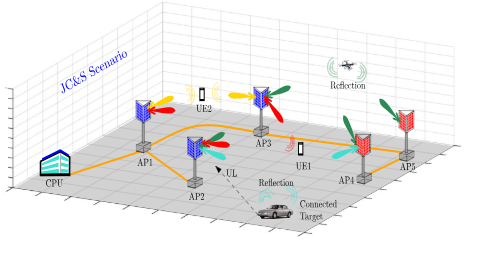Architectures and synchronization of Joint Communication and Sensing networks
Leuven | More than two weeks ago
To support the continuous throughput increase in wireless communication, wide bandwidths are exploited at increasing carrier frequencies, while simultaneously multiple spatial streams are transmitted in parallel thanks to MIMO architectures. Communication network deployments also evolve from centralized point-to-point links to more ubiquitous distributed systems. Those widely deployed networks can now be reused to also support sensing features via so-called Joint Communication and Sensing approaches (JCAS), supporting many new applications such as detecting people and objects, mapping the environment, or assisting network optimization.
In this PhD, you will develop and enhance JCAS solutions operating in bands of a few tens of GHz, where most cellular networks are currently being deployed, up to sub-THz bands where short wavelengths support large antenna arrays and enable fine sensing resolution in range and angular domains.
Successfully realizing JCAS systems requires you to solve many challenges:
- When distributed infrastructure is used for communication and sensing, it requires very accurate synchronization of the timing, clock and carrier of the different nodes, much more than for communication only. In addition, accurate knowledge of the position and orientation of the infrastructure nodes is required. The synchronization, position and orientation requirements depend on the modulation, bandwidth and carrier frequency of the wireless communication system. You will develop novel synchronization algorithms and protocols and test their performance via simulations or experimentally.
- Beyond synchronization challenges, JCAS also requires novel optimization of sensing performance without degrading the communication links. Indeed, unlike pure radar systems having full freedom to use the best sensing waveforms, JCAS is constrained by communication signals carrying random data beamformed towards specific users. You will propose novel algorithms and architectures tuned to maximize sensing performance without degrading communication, while also considering complexity and power consumption limitations.
- In wireless systems, hardware non-idealities such as phase noise, amplifier non-linearity or signal quantization degrade the end-to-end performance, in different ways for communication and sensing systems. You will model the impact of those non-idealities on JCAS systems and search solutions to compensate them where needed.
- Finally, you will find ways to exploit the sensing information to optimize the network (faster beam acquisition thanks to environment knowledge, better allocation between users and access points, preventing link blockage, ...) or to support new opportunistic sensing applications.
As PhD candidate you will be part of a large IMEC team working on the research, implementation and prototyping of future communications and radar systems: experts in digital, analog and mm-wave design, communications systems, radar systems, signal processing and machine learning. This is a unique opportunity to develop innovative, multi-disciplinary technology and shape future wireless and sensing networks. You will publish your research in top-level journals and conferences.

Required background: Electrical Engineering, Signal Processing for Communications, knowledge of radar is a plus
Type of work: 20% literature/theory, 60% modelling/simulation, 20% design/experimental
Supervisor: Sofie Pollin
Co-supervisor: Andre Bourdoux
Daily advisor: Claude Desset
The reference code for this position is 2025-094. Mention this reference code on your application form.
